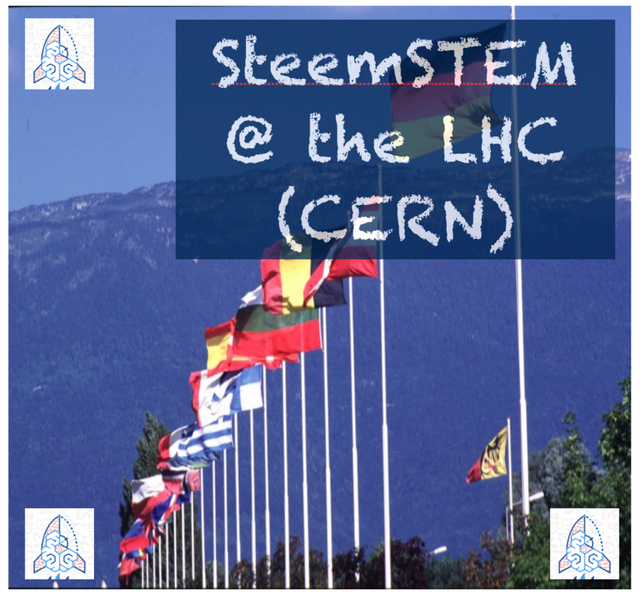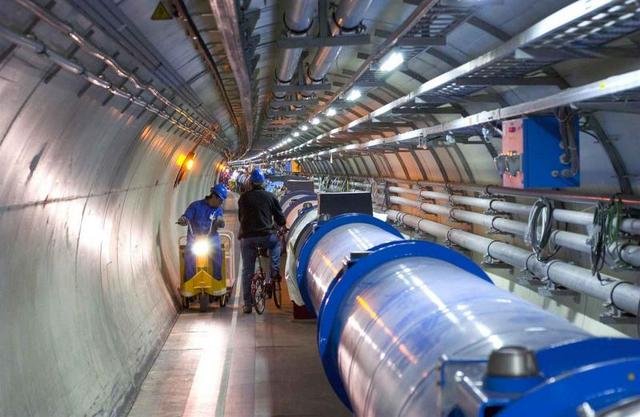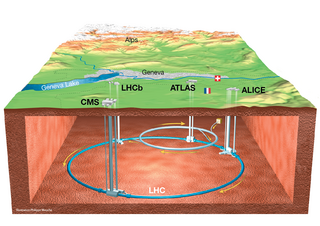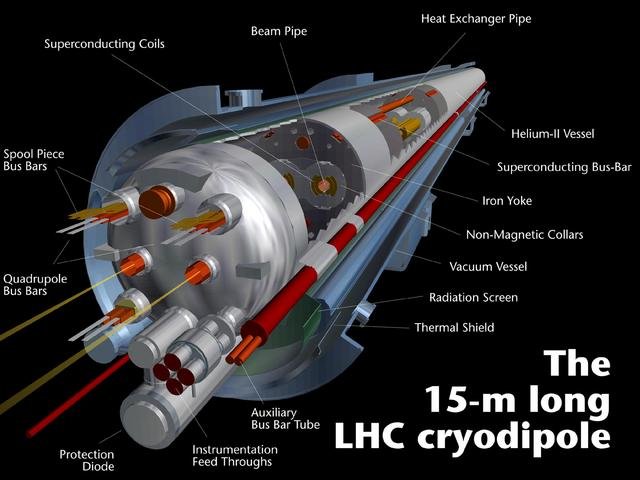A crash course on particle physics (towards our steemSTEM meetup at CERN) - 6 - pushing the frontiers further with particle accelerators
After having discussed the theory of the Standard Model in the first four posts of this particle physics crash course for STEEM, the challenges connected to new phenomena in the fifth post, it is now time to turn to the experimental side, and in particular to accelerators and colliders.

In particular, I will introduce the largest experimental complex that has never been built by humans, the Large Hadron Collider (or the LHC) at CERN, in Geneva (Switzerland).
Thanks the the LHC, the Standard Model of particle is tested into (almost) all of its details, and physicists are looking forward to witness the discovery of new phenomena in a hopefully not too far future. The LHC is also the machine that 20 of us will see in a week, going down 100 meters underground (see here for more information).
For those only interested in funny amazing facts about the LHC, please go down directly to the last section of this article.
PARTICLE ACCELERATORS - THE PRINCIPLE
In order to test our theoretical frameworks, particle physicists have designed large accelerators in which subatomic particles are accelerated, as it could be guessed from the name.
By bringing particles to significant velocities (i.e. by accelerating them), we actually increase their kinetic energy. Therefore, once two of these particles are smashed (or collided), we have plenty of energy available to produce known (and potentially unknown) phenomena.
This is another way to quote Einstein: the production of new massive particles requires large energies, as mass equals energy. It is good to remind that neither the number of particles nor the mass are conserved. This is subatomic physics after all: only the total amount of energy matters (and is conserved).

[image credits: CERN]
But how does all of this work? The idea is very simple. First, we begin with the fundamental principle of dynamics, also known as Newton’s laws of motion.
This law tells us that the force applied to a system is proportional to its acceleration. Therefore, if one wants to accelerate an object, we need to apply some force on it.
Next, one needs to think about how to produce this force. And the idea here is again pretty simple. The particles that we want to accelerate are electrically charged, so that one could rely on the Lorentz force and have fun with electric and magnetic fields.
An electric field will induce a force parallel to it, while a magnetic field will induce a force perpendicular to the velocity and the field.
In other words, electric fields are used to accelerate the particles and magnetic fields are used to control their trajectories.
THE LARGE HADRON COLLIDER AT CERN
Just to insist a little bit: I said hadrons, not hardons…

[image credits: LHC@home]
The LHC is the largest collider machine ever built, and it is located at CERN, across France and Switzerland. It is a ring of 27 kilometers long, buried under the ground at a depth ranging from 45 meters to 170 meters.
The CMS experiment that we will visit is roughly buried at 100 meters under the ground (which is why we will have no 4G in there, so no D-live).
We have actually two rings (inside one tunnel of course), inside which two beams of particles are accelerated and collided at four interaction points (see the figure on the left).
Although the LHC is very well known for accelerating and colliding protons, other types of particles like lead or xenon ions are smashed in there as well. The idea is here to try to shed light on what happened during the very first moment of the universe. This contrasts with proton collisions that are dedicated to the test of the Standard Model and the unraveling of new phenomena.
THE LHC OR PLENTY OF WORLD RECORDS
I now collect a bunch of fun amazing facts about the LHC.
In the LHC tunnel, protons are accelerated at 99.9999999% of the speed of light before being smashed against each other. Yep, this is fast! And actually very energetic… The energy stored within a beam corresponds to the energy of a high speed train (French TGV or German ICE) circulating at 150 km/h!
This means that one collision will happen at an energy larger than the one in the center of the hottest stars!

[image credits: CERN]
This acceleration has been made possible thanks to powerful magnets. Those magnets generate a super-intense magnetic field 100.000 times stronger than the magnetic field of Earth. Another record!
No worries, the machine will be turned of when we will go down inside it.
In order to provide some power to our magnets, one delivers an electric current of 12000 Amperes at a temperature cooler than the one of the void in the universe (1.9 Kelvin). For the sake of comparison, we have roughly 100 Amperes at home…
In terms of electrical power, this corresponds to 120 MW, that is the power provided to all houses in the Geneva canton in Switzerland. Another huge number :)
We cannot speak about the records of the LHC without mentioning the moon… Inside the LHC, the beam circulate in a vacuum of 10-13 bar, which is 10 times less than the pressure… on the moon.
[x] Mentioning the word ‘moon’ in a post that does not discuss the moon: done.
Finally, just to bring one fact from my previous post, we have about one billion collisions per second, and most these collisions are boring… We need to reduce this number by (at least) 10.000.000.000.000 by cleverly selecting the events that are interesting for Higgs physics, top physics, etc.
SUMMARY
In this post, I detailed the basic principles behind particle accelerators, and how we actually accelerate particles. I have then given some details about the LHC before explaining why this machine is just the most amazing machine ever built (okay, my subjective opinion here).
More information can be found on the LHC website, for those who may be interested.
And finally, the previous episodes of this series can be found here: #1, #2, #3, #4 and #5.
SteemSTEM
SteemSTEM is a community-driven project that now runs on Steemit for more than a year. We seek to build a community of science lovers on Steemit and to promote well written/informative Science Technology Engineering and Mathematics (STEM) postings in order to make Steemit a place for fascinating STEM content.
More information can be found on the @steemstem blog and on the Steemit chat and in our last project report.
Thanks for the great post
A question though, when you write, "An electric field will induce a force parallel to it, while a magnetic field will induce a force perpendicular to the velocity and the field."
Isn't electricity and magnetism manifestations of one-in-the-same force?
Just wondering?
@joe.nobel
science fiction, fantasy, erotica
check out the latest post of Andromada, no obligation
You are right: you have two component to the electromagnetic field: an electric field and a magnetic field. These two induce forces that behave differently. The electric field will induce a force parallel to it and the magnetic field a force that is perpendicular both to the field and to to the motion of the particle. Therefore, the magnetic field will change the direction on which the particle is moving.
Instead of smashing random particles together to obtain everytime new infinite particles, the most important phenomenon in science of all should be investigated instead: "Electricity"...
Everyone knows how to use it but no one has come with an explanation to what it is. The only person who came close to an answer is Nikola Tesla, the father of Alternating Current.
Unfortunately, all his papers are being hidden from public view and if "some" infomation have been released... like the recent interview, it has been modified. Same case with the bible...
Well...
Electricity is known for ages... What do you want to learn from there? Also, what does infinite particle mean?
In fact, I have no clue what you are talking about... Sorry.
There's an infinite amount of numbers, therefore there is an infinite amount of particles... same applies to everything you see and cannot see.
Instead of smashing stones to see infinitely other smaller stones... they should investigate/practice something more important than that old procedure.
Electricity has been known for ages yes... but only its phenomenons... its physical appearence and behaviour... no one has come to explain it to what it is... where does it come from... Different phenomena can be seen if you are combining direct current with alternating current or seperately independent of eachother setting them at different frequencies/vibrations, intensities, high/low voltages...
Electricity = Energy.
But where does it come from... what is it? how can you explain the basic phenomena in terms of properties?
To produce electric current, you need a good conductor such as copper and a rotative magnet to rip off/extract current (electricity) from the magnet's magnetic field and deviate/transform/store it into a "recipient/machine"...
That's all there is to produce electricity and use it... but again, what is it?...
Our brain uses electricity by sending impulses to our limbs to control them, same as with other animals, including plants... Everything is electricity...
No one is really looking into it to discover more than we already know...
About the LHC; Everything and anything have advantages and disadvantages so it might be useful in some cases but it really isn't that much of help to our progress in terms of finding patterns...
Well, this is not what we are doing...
Electricity is contrast very well understood at its most fundamental level. Please check is called quantum electrodynamics or QED. This may be a good starting point.
The very first time I heard about the "particle accelerator" was in the movie flash, but I didn't understand much about it. But my knowledge has been enhanced; all thanks to you sir
They actually exist since the 1960s and are at the heart of experimental particle physics research :)
WHAT DO WE WANT??
THE LARGE HADRON COLLIDER!!
WHEN DO WE WANT IT?
NOW!
Can't wait to see video from the meetup soon, look forward to living the trip through your posts haha
We will post them, don;'t worry :) Well, actually, those we have a camera might... :D
I will, definitely! I can't wait to document this trip, and to meet everyone!
First of all, hats off to you. Now i am caught wondering,
You mentioned how about a billion collisions occur in an instant and the need to reduce this number, now my question is this;
By what means do we reduce the collisions?
We don't "reduce" the collision. We have a bunch of collisions, a lot of background and some signal hidden in there. We need to select some of the collisions according to some properties so that the signal selection is close to 1, and the background one as small as possible. A a result, after selection, the signal over background ratio is more acceptable so that we can study the signal.
Is it clearer?
I think so.....so basically we are trying to isolate the collisions of interest while keeping those we are not interested in to a minimum.
Fascinating.....thanks for the explanation.
Yes exactly. For instance, if one is are looking for the Higgs boson in a final state where there are four muons, we will ignore, in our analysis, any collision that does not contain any muon. This sounds logical, but the basic idea is there :)
And another thing that I've been wondering for years ...
Is it a hadron collider which is large.
Or a collider which collides large hadrons?
The machine is larger (27 km long). The particles that are collided are protons or some atomic nuclei. They are thus tiny, and organized into very-well collimated beams with plenty of them.
Is it clearer?
Yes, thanks. Clear. The question was partially tongue-in-cheek.
No problem! My pleasure to clarify :)
I was just about to ask this question till I ran into this. That is great to hear. 100m down? If you could get a 3G signal there, that would be more than impressive. Unless of course, they have repeaters/ signal boosters down there.
Cameras, but not phone network :)
Oh. I see. Thanks.
WOW...
P.s. I'm counting seconds :-D
Still a bunch of them :D
You are very good leader continues. vote for me, I am new. follow me @saizor
I am no leader :D
Nice to read thanks. I will follow you.
Thank you!
Well great job my friend... You are really a great physicist... Keep up the good work...
Thanks for your sympathetic comment! :)